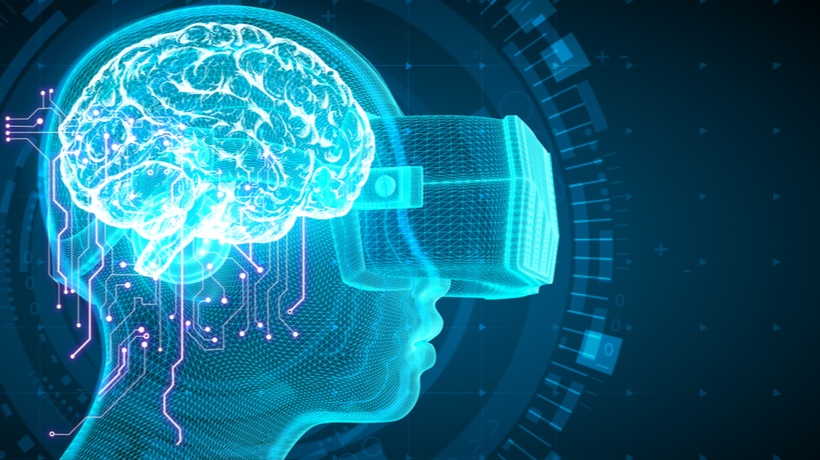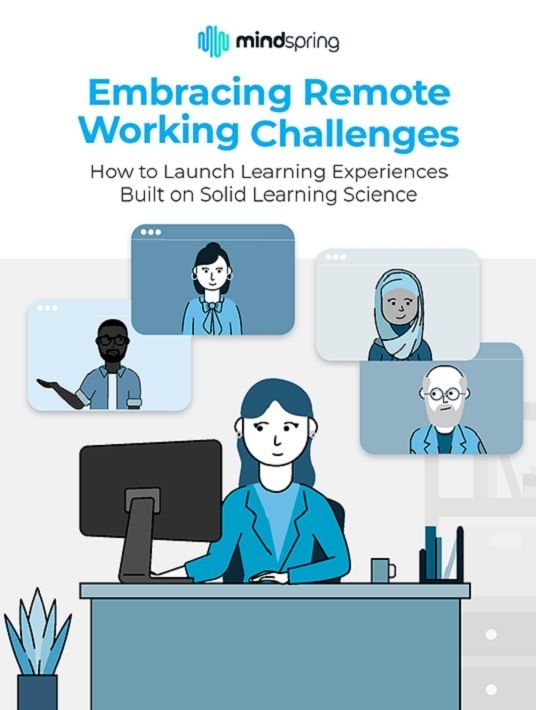
How To Create Engaging Virtual Training Programs Using Learning Science
This article is part of a series on overcoming remote working challenges by building learning experiences that are based on solid learning science. What you are about to read is a fable. The company, AshCom, is fictional, but the learning challenges faced by Kathryn, AshCom’s CLO, and her team are real and commonly shared by learning teams in large organizations. It is our hope that you will be able to connect with the characters, their challenges, and the solutions they discover. We also invite you to read the first eBook in the series.

eBook Release
Embracing Remote Working Challenges: How To Launch Learning Experiences Built On Solid Learning Science
Flexibility is key, but does the time-tested learning science support virtual learning experiences designed exclusively for remote positions?
Pondering Learning Science
Darryl stood at the head of a conference table filled with his colleagues on AshCom’s learning team. Several whiteboards were behind him, cleaned and ready for new thoughts. Lunch had been provided by Kathryn, the CLO who led the team. Kathryn gave a quick overview of the purpose and structure of the lunch-and-learns. They would spend 45 minutes eating lunch and thinking through the various elements of learning science and how they related to virtual learning.
Once everyone settled in, Darryl began. “I’m not sure why I was chosen to go first,” he said, glancing at Kathryn.
Kathryn smiled. “Someone had to go first. No pressure, but you are setting the tone for how these go over the next few weeks. Don’t mess it up. Besides, I gave you an easy topic. How hard can it be to cover basic human brain function and its relationship to remote learning?”
Almost everyone laughed. The corners of Darryl’s mouth turned up a bit, but no one would call it a laugh. He decided to dive right in.
“The first thing I need to do is give something of a disclaimer,” he said. “Actually, two disclaimers. The first is personal. I don’t claim to be an expert on brain science. I studied cognition in my master’s program as part of my instructional design degree, but it was a while ago.”
“Tell me about it,” responded Amy, who was significantly older than Darryl.
“The second disclaimer,” said Darryl, “is that this is very much a developing field of research. It seems we don’t have anything close to a complete understanding of the human brain and how it works.”
“That will likely be true for each topic we will cover in the coming weeks,” said Kathryn. “We don’t need to go 5,000 feet deep, and our purpose isn’t to debate the science itself. We need a basic understanding and a view of how it’s related to the plans we are going to be rolling out.”
What Is Cognition?
“And basic is what you will get,” said Darryl now smiling. “Let’s start with a basic definition of cognition.” He walked to the whiteboard behind him and took a red marker as he continued to talk.
“Cognition at its most basic is the mental process of acquiring, processing, and retaining knowledge and understanding through our senses, thoughts, and experiences.”
Darryl continued, “This process happens both at the conscious and unconscious level. Our brains are constantly engaged in this complex operation even when we’re not aware it’s happening. It is truly remarkable when you think about it. And one of our main responsibilities on our learning team is to create learning experiences that will teach people what they need to know to be successful at our company.”
He paused a moment to let this sink in. Alishia, the youngest member of the team, spoke first. “I guess I hadn’t really thought of it like that. We talk about getting to know our learners, but I usually think of that in terms of age, experience, education, preferences, skills levels, and so on. I haven’t really thought about this side of things. Each employee is engaging with the learning experiences we create at the cognitive level. We are kind of competing for space in their brains.”
“Something like that,” said Darryl. “It is easy to talk about what and how things are retained in the brain, but there is another side to that. We all take in all sorts of sensations and have various experiences that are quickly forgotten. Some aren’t even processed, which is a good thing. So yes, we might be providing a learning experience, but the learner is experiencing and sensing many other things, even in the middle of learning. They might be viewing it, but they’re not processing it.”
“How does that work?” asked Adeena, one of the instructional designers on the AshCom learning team.
Flashy L&D Distractions
“It can happen because too many other things are going on around the learner,” said Darryl. “But we can actually be the cause of it if we throw too much information at the person all at one time, or we build in so many flashy things that we detract from what we are trying to teach.”
“Flashy things?” said Maggie giggling, the most experienced instructional designer on the team.
“I know what you mean,” said Michael, the oldest person in the room. “I’m so busy watching the screen and listening to the audio that if it isn’t presented with care, I have no idea what I’m supposed to be learning.” “That’s called cognitive overload,” said Darryl. “Kathryn’s assignment was to consider brain science and how we could provide a completely virtual training experience for employees who might be remote. Rule 1 is ‘beware of cognitive overload.’ Just because we can add things to virtual learning doesn’t mean we should. It’s also not just screen issues. It can be too much audio, or the audio and screen aren’t aligned, creating all kinds of dissonance as the brain tries to make sense of it.
“Can we call this the ‘Not-too-many-flashy-things’ rule?” asked Maggie.
“Call it what you like as long as we all remember it,” said Darryl.
He continued, “There is a second thing related to cognition that might be helpful for us to consider when talking about virtual learning for remote workers. We can call it ‘Location Learning’,” he said as he wrote it on the whiteboard. The idea is that we tend to learn better if we do learning in a specific place. It even relates to whether we are sitting or standing.”
“Does this mean we would process and retain content if we were all sitting at desks like a fifth-grade classroom?” asked Alishia.
“Something like that,” responded Darryl. “Let me be more specific to virtual learning. Virtual or digital locations are not processed by our brains the same way as actual physical spaces. Anyone ever had a hard time concentrating during a Zoom call done from your home?”
“Of course!” said almost everyone around the table.
Darryl continued, “There are several other factors that might make you feel disconnected or even a little lost, such as distractions in the room that no one else can see. Distractions can be worse because you are not in the location where you usually do your job.”
“Furthermore, you often can only see talking heads, which means you are missing a lot of visible cues from the other people in the meeting. I know that Michael will be covering how sociology informs learning science, and I don’t want to steal his thunder.”
“I appreciate that Darryl,” said Michael.
How Learners’ Brains Work
“But this,” said Darryl, “is something we need to consider. Our brains are not as adept at processing information without the social cues that we are used to seeing. It is a cognitive issue.”
At this point, Kathryn interrupted the conversation. “I know this is our first session and Darryl has done an excellent job of covering his assigned topic at the level I hoped for. I’ve had a lot of these same concerns when thinking about how to provide virtual learning experiences to remote workers. I like the ease of it, and I certainly understand the need. But I worry about its effectiveness, and now—looking at the whiteboard—I know why.”
Everyone, of course, looked at the whiteboard.
Kathryn continued, “Darryl, in the few minutes we have left, can you give us some ways that we might overcome some of these challenges of virtual learning?”
“Glad you asked,” said Darryl. “I have several suggestions. Some of them are fairly easy to implement. Some of them are a little far-fetched for us at this point but may become things we need to learn in the future.”
“First, I think we will need to encourage learners to consistently be in the same space when they are going through a virtual learning experience. That will help overcome some of the location learning issues.”
“Second,” continued Darryl, “we should think about introducing more group games in our learning.”
Adeena, who had been the lead on their first true game created by AshCom’s learning team, let out a “yippee” which was louder than she intended.
“I thought you might like that Adeena,” said Darryl. “Games often engage more senses than passively looking at flat images on a screen. Plus, if gaming has taught us anything, those heavily involved in playing games tend to build strong communities in competition even when they are remote.”
“Third,” continued Darryl, “we should build learning experiences to teach people how to learn remotely. We should name some of these things. It may be that some of our current or future employees already have deep experience in virtual learning, but it may be new for some of them. Let’s consider how we can prepare them for the experience. Let’s prepare their brains for how this is going to go.”
“I like that a lot,” said Kathryn.
Bridging The Geographical Divide
“Fourth,” said Darryl, “we should consider whether or not it might be possible to occasionally get remote workers who are learning virtually connected to one another. I don’t want to defeat the purpose of a remote workforce, but we may find that some remote workers are in close proximity to some of our physical plants. It would be good to get them together every so they get to know each other and build some social connectivity.”
“Sounds like you are intruding into my topic again,” said Michael with a smile.
“Sorry about that,” replied Darryl, returning the smile. “I’m sure we will have forgotten what I discussed by the time it comes for your presentation.”
Kathryn again stepped in. “We have to wrap this up, but you mentioned you had a suggestion that might seem a little farfetched to us at this point time. We haven’t heard that yet, have we?”
“No,” said Darryl. “I kept it for last. There is a world between being physically present and learning remotely on a laptop. We create our own reality through virtual reality. There is much more to discuss here, and we aren’t in the position to implement that now, but it should be on our radar.”
“It already is,” said Kathryn, “and I’m sure we will have that discussion in the coming months, but for now, you’ve given us a solid overview of cognitive science and its relation to remote learning. Just a quick reminder that Martina is up for Wednesday’s lunch. Her topic will be Virtual Learning and Psychology. Thanks, everyone, and have a good afternoon.”
Conclusion
Download the eBook Embracing Remote Working Challenges: How To Launch Learning Experiences Built On Solid Learning Science to discover how you can overcome obstacles with targeted solutions backed by learning psychology and proven methodologies. You can also join the webinar to discover which scientific principles are relevant for remote workforce training.
